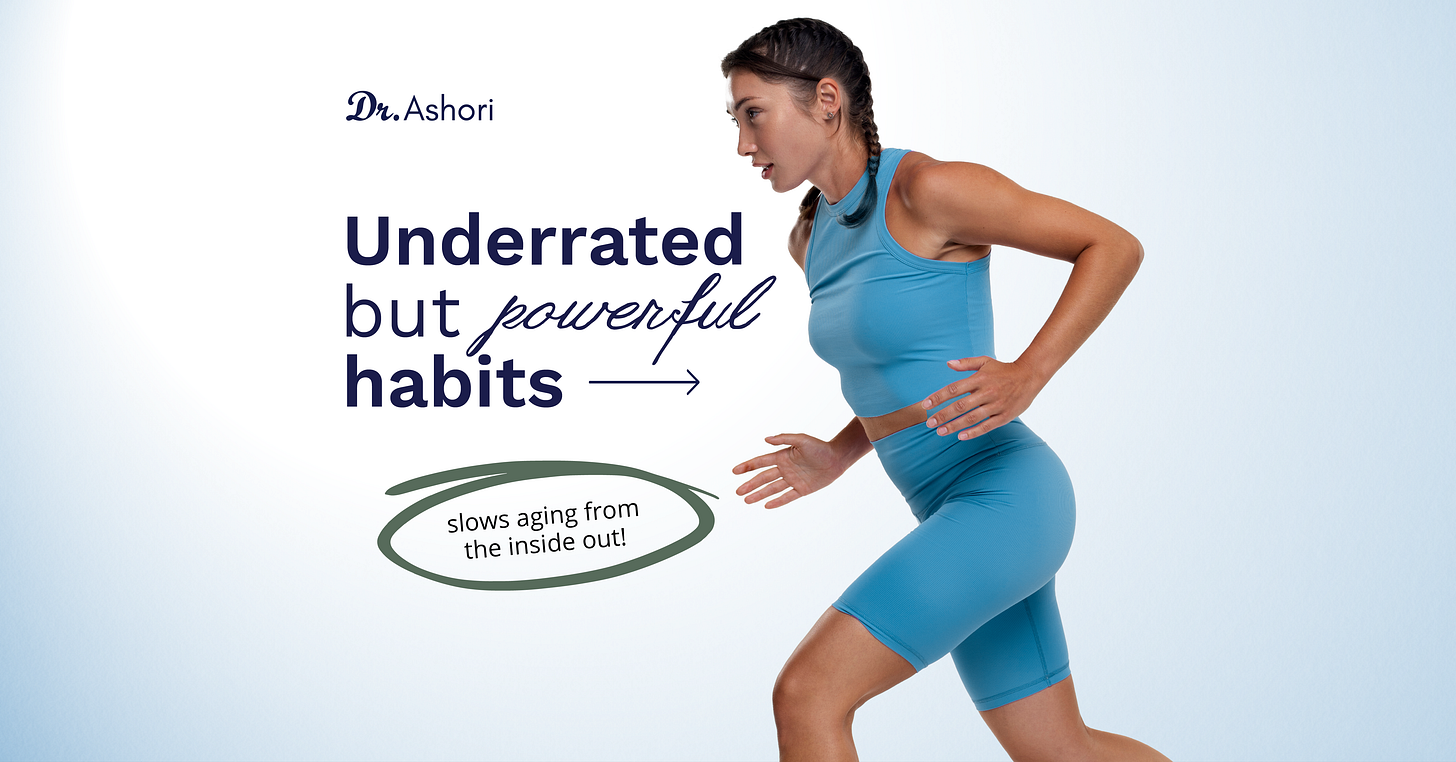7 Habits That Help You Age Healthy
The body has the ability to heal and repair. These are the 7 habits I could fish out of solid clinical literature to help that process along.
UPDATED: August 1st, 2025
Welcome to the Healthy Aging Newsletter, a free publication translating trustworthy medical research into simple habits to age well, free of chronic disease. I’m Dr. Ashori, a family medicine doctor turned health coach.
Celery juice, fasting, and cold plunges have their place on social media but these 7 habits are simpler and science-backed and proven to help the human body age well. These are a collection of habits I’ve addressed with patients over the years and I hope they are just as effective for you.
1. Get Early Morning Natural Light
Some prefer to wake up with natural morning light while others go out for a walk to grab a cup of coffee. Especially if you are struggling with restful sleep, early exposure to natural sunlight can help balance out melatonin levels and help you with your vitamin D levels.
Try a light walk around the block for 5-10 minutes. If you have voice messages to listen to or a favorite podcast, that’ll keep you more engaged.
“I’m not sure if it’s just the walking in the morning or the sunlight but I feel just lighter throughout the day. When I don’t do it, I feel anxious. Also, I’ve noticed so many more bird species that I had no clue about in my own front yard.”
2. Stretching Before Work
Right before sitting down for a marathon of work before your computer screen, a few good stretches can help prevent stiffness, give your body a workout, and activate the lymphatic system for better circulation.
As soon as you sit down for some work, scoot forward in your chair, extend your legs stretching the hamstrings, pulls your arms back for a chest stretch, and do a clockwise gentle circle with your neck.
“I’m not a ‘plan a gym day’ kind of woman. But these micro moments of stretching have resolved my nagging herniated disc in my neck. The same disc my surgeon wanted to fuse.”
3. Challenge Your Tastebuds
Over the years, your tongue has gotten accustomed to certain flavors, sweets, sour, or salty. We enjoy fatty foods with salt, sweet foods with sour notes, etc. We don’t often get enough bitter flavor from arugula, radicchio, or lemon water.
This not only can help with digestion, train brain plasticity, but also retrains the tastebuds to be less reliant on the old standbys. This is an important ‘skill’ to be eventually shift a diet from less desirable foods to foods more aligned with your health goals.
If you like sweets, try a darker chocolate. If you prefer salty, try something more sour.
“I was told by my rheumatologist that I had to cut a certain food out that I loved, loved. It was devastating. Then my nutritionist told me to try to change things up with my tastebuds. She literally said ‘throw them for a loop’ and your cravings will change. It did.”
4. Tune Into Your Stress
We often try to avoid stressful thoughts or realize thoughts and feelings that are intense. It’s a good practice to tune into such strong emotions and really let yourself feel them - free of any judgment, of course. It often will calm your stress and make you less afraid of confronting emotions as a part of your healthy aging journey.
Try to reflect on your stressors with a journal to reduce their intensity. Write about a stressful or negative emotion until you run out of words. No censoring.
“My wife always journal so I decided to try it. I didn’t know how but I found this exercise where you just write everything that comes to your head. No punctuation or anything, it’s like letting it all spill out. Really fascinating what comes out.”
5. Snack a Little More Intentionally
In my nutrition plans with clients I always incorporate snacking. But there is a worthwhile practice of skipping a snack especially when the craving is overwhelming. The time when your blood sugar is really low or anxiety is high, the body may crave a snack.
Try creating a no-snack window in your day that spans 3-4 hours and see if your energy changes or your digestion improves. You expand or shorten this time as needed.
“I got tired of restricting my eating so I switched to having a more designated window when I can snack. Usually it’s the same every day but sometimes I work off-site so I adjust it accordingly. I don’t feel as restricted this way.”
6. Become Aware of Cravings
When I’m distracted it’s common for me to reach for my cell phone to check for text messages, voicemails, emails, etc. When the urge comes, notice it, grab your phone if you need to, but resist the temptation to dig into it. Part of healthy aging is to calm the mind and give it cues for relaxation.
Try going for a walk with your phone at home. Or just spend a day running errands with dedicated times of when you’ll reach for your phone.
“What I do is reach for the snack or my tablet when I feel like scrolling and I just wait a moment. I count. It gives me a little less of a dopamine feet I feel when I just have those few minutes of pause.”
7. Breathing Exercises Before Bed
Most of the day we are bombarded with stimuli - good and bad. Breathing often gets shallow and that can put us on that sympathetic edge. Healthy aging is about creating a good balance between the parasympathetic and sympathetic nervous system.
Try to lay completely flat on your bed with the pillow to the side. Place your hands on your chest and abdomen, take in a deep breath, let it out slowly. Try it any way that feels good, as long as it doesn’t make you anxious, focusing on extending the outbreath.
“My mind would always go to ‘what did you do today to embarrass yourself’ every time I’d put my head on my pillow. Now, I do this breathing exercise where I focus on my breath which slows it down. By the time I’m done, it’s morning time and I’m awake.”





